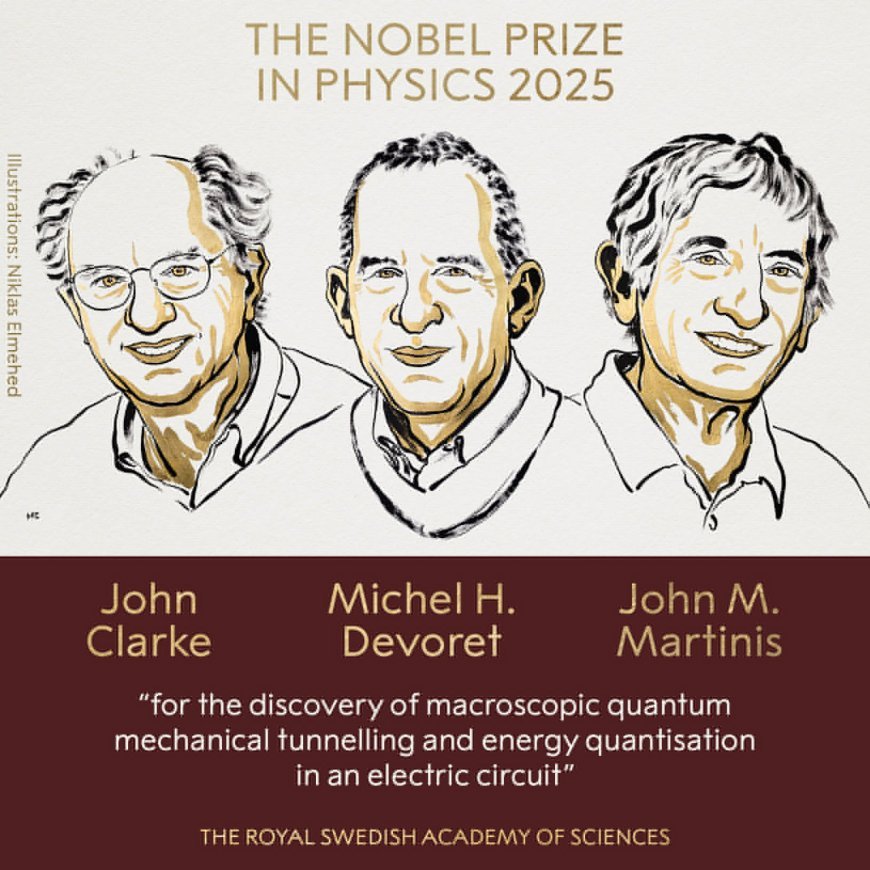🏆 2025 Nobel Prize in Physics: Honoring Quantum Pioneers John Clarke, Michel H. Devoret, and John M. Martinis
The 2025 Nobel Prize in Physics honors John Clarke, Michel H. Devoret, and John M. Martinis for discovering macroscopic quantum tunneling and energy quantization in electric circuits — a breakthrough powering the future of quantum computing.

Introduction: The 2025 Nobel Prize in Physics Recognizes Quantum Breakthrough
The 2025 Nobel Prize in Physics has been awarded to John Clarke, Michel H. Devoret, and John M. Martinis for their groundbreaking discovery of macroscopic quantum mechanical tunneling and energy quantization in an electric circuit.
This achievement bridges the mysterious world of quantum mechanics with real-world electrical systems — opening new frontiers for quantum computing, superconducting circuits, and next-generation electronics.
What Is the Discovery About?
Quantum mechanics describes how particles behave at the smallest scales — electrons, photons, and atoms. Traditionally, these behaviors seemed impossible to observe in the macroscopic world.
However, through decades of research, Clarke, Devoret, and Martinis demonstrated that quantum effects like tunneling and energy quantization could appear in superconducting electric circuits large enough to be handled in the lab.
Their experiments, built around Josephson junctions — two superconductors separated by a thin insulating barrier — proved that current in these circuits can tunnel through energy barriers, showing that entire electrical systems can behave like quantum particles.
This discovery confirmed one of physics’ most exciting ideas: quantum mechanics can govern not just the invisible world, but also engineered systems we can see and use.
How the Discovery Works: The Quantum Circuit Revolution
At the heart of their Nobel-winning work lies the Josephson effect, where superconducting electrons (known as Cooper pairs) move without resistance.
When placed in a controlled circuit, the current behaves like a quantum object — capable of tunneling through energy barriers and existing in discrete energy states.
In simpler terms, these scientists made electric circuits behave like artificial atoms — obeying the same rules of quantum energy transitions.
This innovation gave rise to superconducting qubits, the building blocks of today’s quantum computers. These circuits can store and process quantum information with incredible precision, enabling computations that classical computers cannot perform.
Why the 2025 Nobel Prize in Physics Matters
The Nobel Committee emphasized that this discovery is not only a triumph of fundamental science but also a foundation for quantum technology.
1. Bridging Quantum and Classical Worlds
Clarke, Devoret, and Martinis proved that quantum effects can exist in circuits large enough for practical use — breaking the boundary between microscopic and macroscopic physics.
2. Building the Future of Quantum Computing
Their experiments directly influenced today’s leading quantum computing systems, from superconducting qubits used by Google to advanced quantum sensors and amplifiers.
3. Unlocking Quantum Engineering
Energy quantization in circuits now powers sensitive detectors, secure communication systems, and precision measurement tools.
About the Laureates
-
John Clarke (University of California, Berkeley) — Known for pioneering work on superconducting devices like SQUIDs (Superconducting Quantum Interference Devices), crucial for measuring magnetic fields and studying quantum circuits.
-
Michel H. Devoret (Yale University) — A key figure in quantronics and circuit quantum electrodynamics, integrating quantum theory into real-world circuits.
-
John M. Martinis (University of California, Santa Barbara) — A trailblazer in developing superconducting qubits and architecting scalable quantum computing systems.
Their combined efforts shaped how scientists design, manipulate, and understand quantum systems today.
Quantum Physics Becomes Tangible
The Nobel Committee’s recognition symbolizes a shift in how we view quantum physics. What was once confined to atomic scales is now being built, tested, and optimized in laboratories around the world.
The discovery of macroscopic quantum tunneling and energy quantization in circuits bridges imagination with application — paving the way for quantum technologies that could revolutionize computation, communication, and sensing.
Conclusion: A Quantum Leap into the Future
The 2025 Nobel Prize in Physics celebrates a monumental step forward — transforming abstract quantum principles into engineering reality.
By proving that quantum mechanics governs systems we can build and measure, John Clarke, Michel Devoret, and John Martinis have laid the groundwork for the quantum technology revolution.
Their discovery is not just about physics — it’s about redefining the limits of what’s possible.
What's Your Reaction?
 Like
0
Like
0
 Dislike
0
Dislike
0
 Love
0
Love
0
 Funny
0
Funny
0
 Angry
0
Angry
0
 Sad
0
Sad
0
 Wow
0
Wow
0




























